K. Van Wychen Bennett, W.D. Hutchison, E.C. Burkness, R.L. Koch, & B. Potter
Department of Entomology, University of Minnesota
Introduction
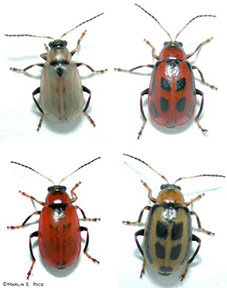
The bean leaf beetle (BLB), Cerotoma trifurcata, is an occasional pest of snap bean (Phaseolus vulgaris) throughout the eastern U.S. and in recent years, in the upper Midwest production regions of southern Minnesota and Wisconsin. Recent outbreaks since 2000 have been attributed to milder winters or adequate snow cover to insulate overwintering adult populations. Other hosts include soybeans (Glycinemax), peas (Pisum sativum), clover (Trifolium spp.), cowpeas (Vigna unguiculata), dry edible beans (Phaseolus vulgaris), and several leguminous weeds.
Biology & Life Cycle
BLB adults are about ¼ inch in length. They range in color from greenish yellow to red with a black triangle directly behind their head (see photos). Although a variety of color forms occur in the Midwestern U.S., the vast majority of BLB in Minnesota are yellowish-green with black markings. The wings are usually outlined in black and have four black spots. BLB overwinters as adults near the soil surface, under leaves in woods close to bean fields or in stubble left in fields. During the spring of 2003, the majority of adult BLB surveyed in Minnesota were found to be overwintering in soybean residue remaining from 2002, particularly in fields that had been in soybean the previous year.
Overwintering BLB emerge in mid-May to early June and start to feed before mating. The females lay orange eggs in the soil in clusters of about 12, around the base of beans or other suitable host plants. Eggs hatch one to three weeks later, depending on temperature. Upon hatching, the larvae feed on nodules and roots of plants (generally legumes). Larvae are white with brown heads. Pupation occurs in the soil in earthen cells. The next generation of adults (F1) is generally found on host plants from mid-July through September. There is typically only one generation per year in Minnesota, but two generations are most common in the southern part of the state. In the latter case, the first generation appears in July and the second generation appears in late August - September.
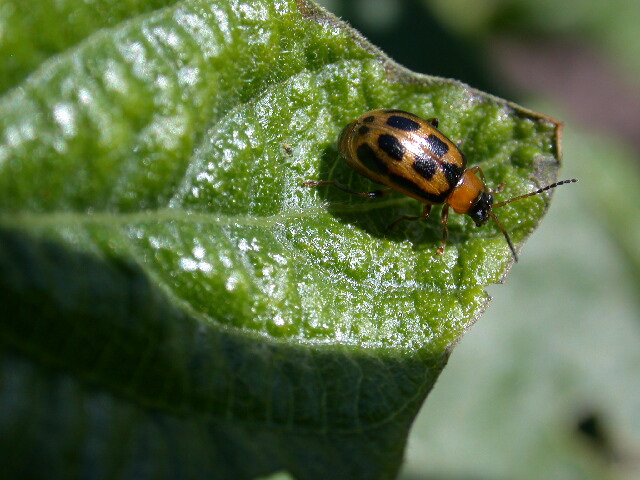
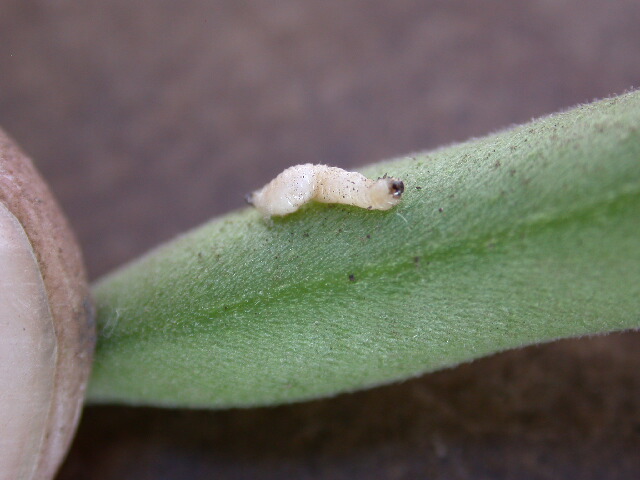
Damage
Adult beetles prefer young, tender tissue. Adults feed primarily on the undersides of leaf surfaces, creating large (3-4 mm diameter), round holes. High populations of adults can rapidly destroy the small cotyledons of snap beans, completely defoliate the first true leaves, and subsequently kill young seedlings. Extensive defoliation can reduce the vigor and yields of bean plants. During pod set, adults will also feed on the outer surface of bean pods causing cosmetic damage and providing an entry point for fungal diseases. Pod damage will be minimal, however, if insecticides are being applied for other pests at this time, such as European corn borer. BLB adults may also transmit the following viruses: bean pod mottle, cowpea mosaic, and southern bean mosaic. The presence of a virus is often depicted by symptoms of stunted growth and a mosaic pattern on leaves. Although larvae feed on root systems and nodules, the economic impact is not well documented.
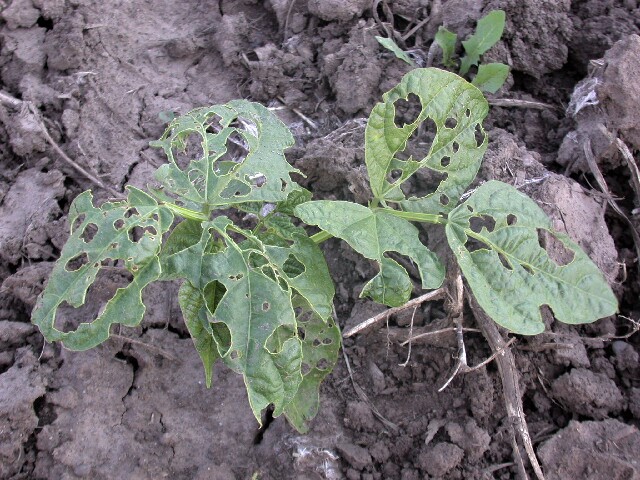
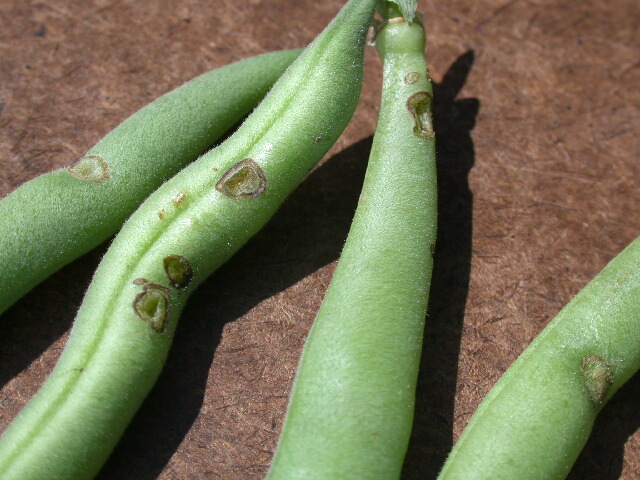
Management Options
Other insects such as flea beetles, grasshoppers, Japanese beetles, spotted cucumber beetles, and slugs can also chew holes in leaves. Holes caused by flea beetles are much smaller than those of BLB. BLB eat completely through the smaller veins and leaf blade. Holes caused by the spotted cucumber beetles, however, are similar to the damage caused by BLB. During 2003, excessive seed corn maggot (SCM) feeding on cotyledon tissue (below soil surface) also resulted in small holes that were sometimes difficult to distinguish from BLB feeding. However, the damage attributed to SCM consisted of smaller and more jagged feeding patterns compared with those of BLB.
New research is currently underway in Minnesota to determine an appropriate economic or action threshold for adult feeding damage on snap bean. However, based on data collected during the 2001-2002 field seasons, a preliminary action threshold has been developed. Control should be considered if more than 10% of the seedlings in the cotyledon to first trifoliate stages exhibit more than 25% defoliation (e.g., 6-10 "shot-holes" per leaf). If this threshold is exceeded, there are several foliar insecticides that can be applied for control. Most of these insecticides should work well at the mid-rate range. Based on additional research during 2003-2004, this threshold may be revised.
Insecticidal Control - Foliar Treatments
The following insecticides are currently labeled for BLB control on snap beans: Asana XL, Di-Syston 15G, Orthene/Address 75S, Capture 2EC, Mustang 1.5EW, Sevin XLR, and Warrior. Since BLB move into snap bean over a prolonged period, insecticides with short residual and low rates may provide disappointing control. To ensure proper use of insecticides, refer to the most recent edition of the Midwest Vegetable Production Guide, or product labels.
Insecticidal Control - Seed Treatments
Recent research regarding insecticide-treated seed has shown promising results in controlling BLB (Hutchison et al. 2003). However, justifying the cost of seed treatment may be difficult to determine because BLB damage is still difficult to predict and damage/yield relationships are unknown. . Knowledge of BLB infestations in a snap, dry edible and/or soybean in a given production area during the previous year can help assess the local risk of damage to snap beans for the current year. In addition, depending on the latitude (e.g., in Illinois), it may be that normal snap bean planting dates will more often coincide with BLB overwintering emergence. The decision to have seed treated will also depend on the cost of new insecticide products.
Despite these caveats, future advancements for BLB management will likely benefit from at least two new insecticides, both referred to as "neonicotinoids," due to unique modes of action within the insect's nervous system. Two recent products, Gaucho (Gustafson) and Cruiser (Syngenta Corp.) are unique in that they provide both direct protection from soil-borne insects to the developing root tissue, as well as systemic activity throughout the seedling, from germination to about 3-4 weeks following emergence. Both products provide excellent early season protection from BLB adult feeding. In addition, both treatments provide control of the Potato Leafhopper (PLH) and likely assist with controlling early-season aphid infestations. As of May 2003 however, only Gaucho was currently labeled for snap bean (as well as sweet corn and other vegetables). Cruiser is labeled for sweet corn, but the application for snap bean is still pending. It is interesting to note that in Minnesota trials, Cruiser provided a slight, but a statistically higher level of BLB control over Gaucho (Koch, Burkness, Hutchison & Rabaey, unpublished data). In similar studies in New York and Minnesota, Cruiser also provided significantly higher levels of PLH control (B. Nault, Cornell Univ., personal communication, 2/03).
Cultural Control
Delaying the snap bean planting date in a given region may be one of the best strategies for minimizing the risk of BLB damage in spring to early summer. In southern Minnesota and Wisconsin, typical early to mid-June planting dates for many processing varieties will likely escape most damage by overwintering adults. However, fresh market snap beans, planted by growers who desire early planting dates to increase the odds of higher prices with early harvests, will continue to be at risk from BLB damage. Avoid cutting adjacent host crops such as alfalfa, to prevent resident BLB adults from moving into adjacent snap bean fields.
Biological Control
A tachinid species, Medina sp (not identified to species level) is the most effective natural enemy of BLB in Minnesota. Based on one year of data (1984), the average parasitism rate near an alfalfa field was 40%. However, the average parasitism rate of BLB was much lower (3%) in a soybean field that was not next to alfalfa. In a soybean field adjacent to an alfalfa field, the parasitism rate of the overwintering BLB's reached 90%. The maximum parasitism rate of the F1 generation was 58%. The parasitoid is not commercially available for augmentative biological control, but could help suppress BLB populations each year.
References
Capinera, J. L. 2001. Handbook of Vegetable Pests. 729 pp. Academic Press. New York.
Cornell University. 2003. Vegetable Disease ID and Management http://vegetablemdonline.ppath.cornell.edu/
Foster, R. & B. Flood. 1995. Vegetable Insect Management. Meister Publishing Co. Willoughby, Ohio.
Hutchison, W.D., E.C. Burkness, R.L. Koch & T.L. Rabaey. 2003. Efficacy of systemic seed treatments in snap bean and sweet corn: 2002 update. In: Proc. Midwest Food Proc. Assoc., La Crosse, WI, February 24-25. 15: 159-171.
Koch, R.L., E.C. Burkness, W.D. Hutchison, and T.L. Rabaey. 2005. Crop Protection. 24: 734-742.
Loughran, J.C. and D.W. Ragsdale. 1986. Life Cycle of the Bean Leaf Beetle, Cerotoma trifurcata (Coleoptera: Chrysomelidae) in Southern Minnesota. Ann. Entomol. Soc. Am. 79: 34-38.
Loughran, J.C. and D.W. Ragsdale. 1986. Medina sp. (Diptera: Tachinidae): A New Parasitoid of the Bean Leaf Beetle: Cerotoma trifurcata (Coleoptera: Chrysomelidae). J. Kan. Ent. Soc. 59: 468-473.
Metcalf, R.L. & R.A. Metcalf. 1993. Destructive and Useful Insects. 5th Edition. McGraw-Hill, Inc. New York.
Purdue University. Midwest Vegetable Production Guide for Commercial Growers; https://mwveguide.org/